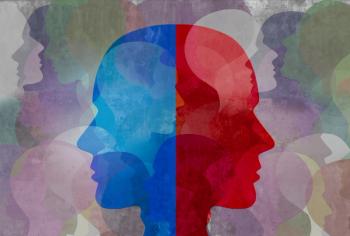
- Vol 38, Issue 4
- Volume 04
Exploring the Link Between Neuroticism-Depression and College Drinking
Although college drinking develops into an addiction, overconsumption and especially binge drinking patterns are often preludes to alcohol use disorder, with approximately 1 in 10 students meeting criteria for AUD.
JOURNAL CLUB
Binge drinking is defined as consumption of 5 or more standard drinks on 1 occasion for males, or 4 or more for females, bringing blood alcohol concentration to 0.08 grams of alcohol per deciliter or higher.1 These drinking patterns lead to serious health and safety risks, including
Perhaps not surprisingly, national surveys have found that half of full-time
The first few weeks of freshman year are often a period of heavy drinking and alcohol-related consequences. Social pressures and expectations during new-found independence, widespread availability and access to alcohol, unstructured schedules with mounting academic pressure, and lack of parental interactions all play a role. Alongside these stressors, many students have preexisting personality traits that may account for the use and misuse of alcohol during college.
Neuroticism, 1 of the 5 higher order personality traits, is defined by high emotional instability, depressed mood, low frustration tolerance, and anxiety. It also has been found to positively predict alcohol consumption (social intake within recommended parameters)9-11 and alcohol use (intake beyond recommended parameters that can lead to addiction).12 Only 1 previous study of 200 college students evaluated the implications of personality types; that study found high neuroticism and low conscientiousness predicted more
Martin and colleagues14 aimed to better understand the role of personality and neuroticism in college alcohol use/misuse among freshman, above and beyond the reported levels of stress. The starting hypothesis revolved around the notion that negative affect faces of neuroticism, and primarily
Structured Investigation
Martin and colleagues14 conducted a cross-sectional outpatient study, which was approved by the Institutional Review Board. Survey data was collected from participants during the first 8 weeks of their first college semester. Participants included 211 female and 90 male matriculating college freshmen with an average age of 18.58 years (SD = 0.39) from 2 campuses of a private university in the southeastern United States, spanning both urban and rural areas. Students were recruited via fliers posted on campus and during frequent in-person undergraduate events.
Data was acquired via online surveys of behavioral, health questionnaires, and cognitive assessments. Most surveys were completed within 3 weeks of the study initiation, and participants received a $15 gift card for completion. The Alcohol, Smoking and Substance Involvement Screening Test (ASSIST) and the Alcohol Use Disorders Identification Test (AUDIT) were used to assess alcohol use and misuse (
Endorsement of use 1 or more times on the ASSIST prompted the administration of the AUDIT, a 10-item questionnaire with a maximum score of 40 for which the higher scores indicate more severe and hazardous, harmful, excessive alcohol use/misuse. Stress was assessed using the Perceived Stress Scale (PSS), a 14-item self-reported measure of stress with each stress symptom scored on a 4-point Likert scale, where 0 = never and 4 = very often (maximum score of 56). Personality was assessed using the 44-item version of the Big Five Inventory (BFI), which measures 5 dimensions of personality (openness to experience, conscientiousness, extraversion, agreeableness, and neuroticism).
Ten facet traits were also calculated to assess more specific personality characterization within the 5 domains: openness, aesthetics, and ideas; conscientiousness, order, and self-discipline; extraversion, assertiveness, and activity; agreeableness, altruism, and compliance; and neuroticism, anxiety, and depression.
Analyses controlled for campus site (rural vs urban), sex, and individual week of study enrollment (school obligations as potential stressors fluctuated between study weeks). The investigators examined partial correlations between predictions while controlling for covariates. They used multiple regression analysis to examine the conditional and joint effect of personality and stress on alcohol use and misuse.
Analyzing the Results
Of the sample, 54% (or 164 individuals) endorsed use of
Regression analyses provided less biased estimates of personality and stress on AUDIT. To elucidate the relationship between neuroticism, stress, and
Exclusion of all personality traits except for neuroticism-depression did not explain more variance in AUDIT (adjusted R2 = .10, F (5, 152) = 4.56, P < .001). Interaction effects found that neuroticism as a domain moderated the relationship between PSS and AUDIT (β = .16, P = .040; adjusted R2 = .12, F (10, 146) = 3.16, P = 0.001). This interaction was found to be unique. Neuroticism-depression score moderated the relationship between PSS and AUDIT-T (β = .18, P = .020; adjusted R2 = .14, F(11, 145) = 3.22, P < .001. At low levels of the depression facet, stress was negatively associated with alcohol use and misuse, but at high levels of the depression facet, stress was positively associated with alcohol use and misuse (
Discussion
This study supports the notion that neuroticism, and specifically the neuroticism-depression facet, appear to be the most robust predictors of alcohol use and misuse among incoming freshmen and could serve as useful population risk indicators. At low levels of the depression facet, stress was negatively associated with
Investigators branched off previous studies exploring the roles of personality or stress on college drinking. They analyzed survey results data from Wave I of the MAPme Project, a longitudinal study of biobehavioral health and substance use during college. Those findings showed that personality characteristics and
Unfortunately, this study had a number of limitations. Due to issues with the sample population, the findings may not generalize to other student populations. This study was conducted using a primarily Caucasian group from a private university located in the southeast US, without ensuring varied socioeconomic statuses. Similarly, although the sample encompassed both urban and rural participants, they were located in the same part of the country. The study also included a greater proportion of women compared to men, which may have skewed the baseline starting characteristics and outcomes.
Other issues can impact the findings. For instance, there were fairly low numbers of reported alcohol use among the sample to confidently generalize findings. Compensation offered to participants may add external biases and contribute to participant selection and participation.
The authors used a single-domain, self-reported assessment of stress, associated with increased likelihood of response bias and social desirability bias. More comprehensive and objective measures of stress levels might include physiological assessment, such as skin conductivity, heart rate, or cortisol measures that have shown be strongly associated with perceived stress.
The study employed the AUDIT-Total score, which confounds alcohol consumption and problematic alcohol use behaviors. The study participants reported low alcohol use and misuse behaviors, but the tool was not well prepared to detect unique effects of each of these constructs. Thus, future research could expand on this study by examining alcohol consumption and problems separately.
This study is limited by its cross-sectional design. To best examine the relationship between stress and personality on alcohol use and misuse, future studies could take a longitudinal state-trait perspective, treating personality and neuroticism specifically as stable traits and stress as a state.
Fortunately, data from this sample will continue to be collected until the students graduate, allowing longitudinal examinations into alcohol use and misuse trajectories, and the associations between stress, personality traits, and hazardous and harmful alcohol use.
So what does this mean for clinical practice? When presented with highly stressful circumstances, high neuroticism-depression in individuals predicts propensity to use and misuse alcohol. Similarly, people with high neuroticism-depression are likely to drink more when stressed, but low neuroticism-depression seems to be protective, with these individuals using and misusing alcohol at lower rates. Finally, the BFI domains and faces seem to have a role in alcohol use/misuse, above stress levels. These could be used as screeners for population risk indicators among incoming freshmen.
Dr Stanciu is assistant professor of psychiatry at Dartmouth’s Geisel School of Medicine and Director of Addiction Services at New Hampshire Hospital, Concord, NH. He is Addiction Section Editor for Psychiatric TimesTM. The author reports no conflicts of interest concerning the subject of this article.
An earlier version of this article appeared online on February 10, 2021, under the title Neuroticism-Depression: What Is It and Does It Play a Role in College Drinking? and has since been updated for print. -Ed
References
1. National Institute on Alcohol Abuse and Alcoholism. NIAAA council approves definition of binge drinking. NIAAA Newsletter. 2004;3:3. Accessed February 5, 2021.
2. Hingson R, Zha W, Smyth D. Magnitude and trends in heavy episodic drinking, alcohol-impaired driving, and alcohol-related mortality and overdose hospitalizations among emerging adults of college ages 18-24 in the United States, 1998-2014. J Stud Alcohol Drugs. 2017;78(4):540-548.
3. Hingson R, Heeren T, Winter M, Wechsler H. Magnitude of alcohol-related mortality and morbidity among U.S. college students ages 18-24: changes from 1998 to 2001. Annu Rev Public Health. 2005;26:259-79.
4. US Department of Health and Human Services. Center for Behavioral Statistics and Quality, Substance Abuse and Mental Health Services Administration. 2019 National Survey on Drug Use and Health. Table 6.21B—Types of Illicit Drug, Tobacco Product, and Alcohol Use in Past Month among Persons Aged 18 to 22, by College Enrollment Status and Gender: Percentages, 2018 and 2019. Accessed February 5, 2021.
5. Wechsler H, Lee JE, Kuo M, et al. Trends in college binge drinking during a period of increased prevention efforts. Findings from 4 Harvard School of Public Health college alcohol study surveys: 1993-2001. J Am Coll Health. 2002;50(5):203-17.
6. Presley CA, Pimentel ER.
7. US Department of Health and Human Services. Center for Behavioral Statistics and Quality, Substance Abuse and Mental Health Services Administration. 2019 National Survey on Drug Use and Health. Table 6.23B—Alcohol Use Disorder in Past Year among Persons Aged 18 to 22, by College Enrollment Status and Demographic Characteristics: Percentages, 2018 and 2019. Accessed February 5, 2021.
8. Stanciu CN, Penders TM, Wuensch KL, et al. Underutilization of screening tools for alcohol use disorders – part I: results from survey of practices among North Carolina mental health providers and brief review of available instruments. J Alcohol Drug Depend. 2017;5(5):100282. Accessed February 5, 2021.
9. Allen MS, Vella SA, Laborde S. Health-related behaviour and personality trait development in adulthood. J Res Pers. 2015;59:104–110.
10. Cooper ML, Agocha VB, Sheldon MS. A motivational perspective on risky behaviors: the role of personality and affect regulatory processes. J Pers. 2000;68(6):1059-1088.
11. Loukas A, Krull JL, Chassin L, Carle AC. The relation of personality to alcohol abuse/dependence in a high-risk sample. J Pers. 2000;68(6):1153-1175.
12. Goldstein AL, Flett GL. Personality, alcohol use, and drinking motives: a comparison of independent and combined internal drinking motives groups. Behav Modif. 2009;33(2):182-198.
13. Ruiz MA, Pincus AL, Dickinson KA. NEO PI-R predictors of alcohol use and alcohol-related problems. J Pers Assess. 2003;81(3):226-236.
14. Martin KP, Benca-Bachman CE, Palmer RHC. Risk for alcohol use/misuse among entering college students: The role of personality and stress. Addict Behav Rep. 2020;13:100330. ❒
Articles in this issue
over 4 years ago
Sedation: The Ups and Downs of a Side Effectover 4 years ago
Addressing Obesity in Patients Taking Antipsychoticsover 4 years ago
Finding Solutions While Managing Problemsover 4 years ago
Race, Ethnicity, and Chronic Painover 4 years ago
Phenomenology, Power, Polarization, and Psychosisover 4 years ago
In Memoriam: Eulogies for Beloved PsychiatristsNewsletter
Receive trusted psychiatric news, expert analysis, and clinical insights — subscribe today to support your practice and your patients.

















